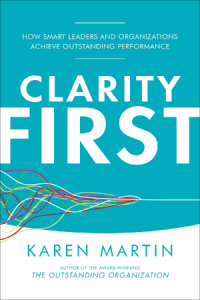Preview Thursday: Clarity First

Best of Books
October 18, 2018
WI Admin
Topics
Ambiguity, clarity, Karen Martin, Preview Thursday, short term benefit We are pleased to present this excerpt from Chapter 1 of: Clarity First: How Smart Leaders and Organizations Achieve Outstanding Performance by Karen Martin.
We are pleased to present this excerpt from Chapter 1 of: Clarity First: How Smart Leaders and Organizations Achieve Outstanding Performance by Karen Martin.
More Than a Moment
It took me forty years on earth To reach this sure conclusion: There is no Heaven but clarity, No Hell except confusion.
—Jan Struther from the poem “Clear”
We have all experienced those moments in life when hard realities present themselves with complete clarity. It’s the moment you realize that the dream job you worked hard to get has taken you away from doing what you love, or that a relationship you’ve invested years of your life in is shifting in a direction that’s different from what you want. Too often, crisis—a near-miss accident or a frightening diagnosis—is the catalyst that brings these revelations. In those moments we are suddenly able to see the reality we had avoided, hidden, or explained away. Those moments are hard, in part because they present difficult choices: change what you are doing, or continue as you have been with the knowledge that what you have is all there will ever be. No surprise, then, that so many people avoid or ignore those moments of clarity.
No surprise, either, that organizations do the same. Ambiguity is the corporate default state, a condition so pervasive that “tolerance for ambiguity” has become a cliché of corporate job postings, a must-have character trait for candidates. Ambiguity is a condition we sink into because it is automatic and it provides short-term benefits that manifest in a number of ways. The manager who posts a vague job description is able to put off defining the specific responsibilities for the role. The project launched with ambiguous purpose leaves the project manager free to interpret results to his advantage. Ambiguity about customer requirements or preferences means you don’t have to work to satisfy them.
As John Lennon wrote in the song “Strawberry Fields Forever,”
“living is easy with eyes closed.”
But is it? The short-term benefits of ambiguous organizational behaviors come at enormous long-term cost. Ambiguity leads to substandard performance, as leaders and team members at all levels invest time and effort on priorities that don’t bring significant benefit. Ambiguity causes people to reach inaccurate conclusions, make faulty decisions, or spin their wheels in nonproductive ways. The absence of clarity also creates an opportunity for biases and assumptions to influence how people interpret information. Ambiguity tempts organizations to be reactive: instead of addressing the most important issues, they address those attracting attention at this moment. Ambiguity prevents organizations from operating with focus, discipline, and engagement.
Lack of clarity insinuates itself into the organization in hundreds of ways, both obvious and insidious.
Lack of clarity runs the meeting with no agenda. It worms its way into the customer complaint that goes unresolved. It allows product quality issues to persist to the point of costly and reputation-sapping recalls, or market-share erosion. It weakens the decision you aren’t sure you have the authority to make, and flashes the exit sign at the talented team members you can’t promote because you still don’t have budget approval four months into the fiscal year. It lurks in the background when you don’t know which of the dozens of metrics really matter, and thus can’t explain what success looks like or how you would know when you reach it. The individual and collective lack of clarity keeps leaders and organizations of all types and sizes from performing to their fullest potential.
It often requires a business crisis and a resulting moment of revelation for leaders to recognize how much ambiguity exists and how much it costs them.
K aren Martin, president of the global consulting firm TKMG, Inc., is a leading authority on business performance and Lean management. Known for her keen diagnostic skills and rapid-results approach, Karen and her team have worked with clients such as AT&T, Chevron, Epson, GlaxoSmithKline, Goodwill Industries, International Monetary Fund, Lenovo, Mayo Clinic, Prudential Insurance, Qualcomm, and the United States Department of Homeland Security to develop more efficient work systems, grow market share, solve business problems, and accelerate performance. As a thought leader and skilled teacher, Karen has shaped how leaders and improvement professionals approach business performance in over 45 countries.
aren Martin, president of the global consulting firm TKMG, Inc., is a leading authority on business performance and Lean management. Known for her keen diagnostic skills and rapid-results approach, Karen and her team have worked with clients such as AT&T, Chevron, Epson, GlaxoSmithKline, Goodwill Industries, International Monetary Fund, Lenovo, Mayo Clinic, Prudential Insurance, Qualcomm, and the United States Department of Homeland Security to develop more efficient work systems, grow market share, solve business problems, and accelerate performance. As a thought leader and skilled teacher, Karen has shaped how leaders and improvement professionals approach business performance in over 45 countries.
Karen’s broad understanding of work system design and business management stems from her experience building and managing operations for several rapid-growth organizations that each grew into multi-billion-dollar companies. She developed a keen understanding of customer value while serving in sales and marketing roles, and has extensive experience mitigating legal and compliance constraints. While she has worked with clients in nearly every sector, her healthcare-rich background includes clinical, administrative, and regulatory work in hospitals, post-acute care settings, payer services, medical research, clinical laboratories, physician practices, integrative medicine and behavioral healthcare.
An in-demand global speaker, Karen wows her audiences with high-energy presentations containing practical takeaways. Audiences giving her high ratings have included groups such as MassMutual, Lenovo, Young Presidents’ Organization, Society for Human Resource Management, and the Association for Manufacturing Excellence.






